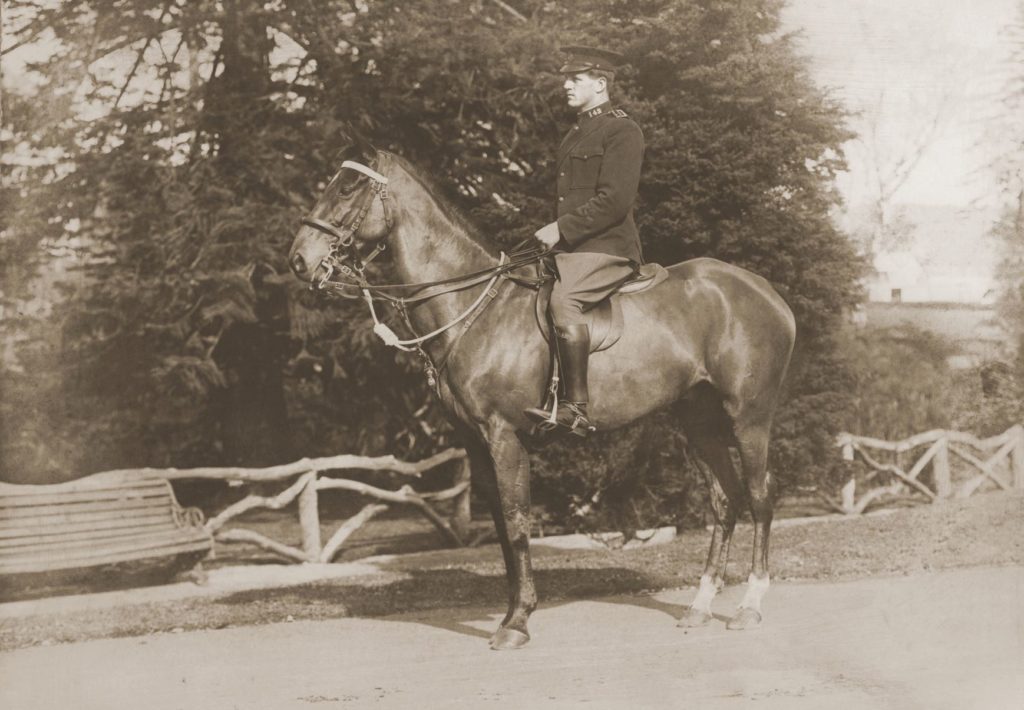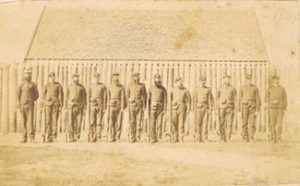
The Police Force in Cambridge
-
The very first European force policing the Cambridge area was the 3rd Regiment of the Waikato Militia. The men erected the Star Redoubt in Fort Street and immediately established a communication line with Pirongia, Hamilton and Te Awamutu.

Armed Constabulary outside the Star Redoubt in Fort Street (ref 2958/1/44)
In 1867, the Armed Constabulary Act was passed and the Waikato Militia was disbanded. The Armed Constabulary were mostly single men recruited in Auckland. Their first job was to repair telegraph communications between Cambridge and neighbouring towns Te Awamutu and Hamilton. They also built roads and bridges, fenced paddocks, put out fires, and provided guard duties.
The NZ Constabulary Force had jurisdiction from 1877 up until 1886, when the NZ Police Force was formed.
The following is a snapshot of policing in Cambridge in the 1930s and 40s. We have chosen Constable Charles Henry Maisey as our subject not only because of his exemplary service to the town, but also because of photographs of him recently donated by his grandson Chris who visited the museum earlier this year. Chris Maisey remembers his grandfather well and hopes his fine head of hair runs in the family.
Tributes for Constable Maisey
In February 1944, the Cambridge Ministers Association lodged an objection with the Police Department. “The Ministers Association of Cambridge learns with regret of the removal of Constable Maisey [to Epsom] … We unanimously agree that the work of Constable Maisey of Cambridge has been above reproach in every respect, and he is held in high regard by both town and country people. Further, we are strongly of the opinion that in the interests of good order a man of Mr Maisey’s character and ability should be retained [in Cambridge].”
But to no avail. In July 1944, when Constable Maisey and his family left for Epsom, the wishes “Haera Ra” went with them. Robert Tairi expressed his thanks to Constable Maisey for his understanding, help and advice and for making Māori feel part of the community. The Mayor thanked Irene Maisey for her community work. Farewell functions were held by the Caledonian Society, Trinity Presbyterian Church and Patriotic Committee, wishing the family all the best in Epsom.
The local Court said that “in both capacities (as Clerk of the Court and Senior Constable) Constable Maisey has won the esteem and regard of all. His work in both spheres has been excellent. We laymen perhaps do not realise to what extent we owe our safe mode of living to the ever watchful vigilance of our police force throughout the country, and Constable Maisey is a worthy member of that force.” The presiding Magistrate added “Constable Maisey had been not only a capable and conscientious officer but a just one. His object had been more to maintain order and security in the town, than to bring offenders before the court. His work both as Clerk and as prosecutor had been faithfully and justly carried out.”
Service in Cambridge
Harry Maisey (known as Charlie by his family) had arrived in Cambridge with his wife Irene and five children nine years earlier in 1935. He had served on the police force since 1913 at Avondale, and then at Waipu. After a short stint back in Avondale, he was transferred to Cambridge as Officer-in-Charge.

Harry and Irene Maisey married on 18 June 1919 in Auckland (ref 4448/2)
He was one of New Zealand’s last qualified mounted policemen. He wore his brown riding breeches and leggings while on duty, and kept his horse Mac in a paddock at the rear of the station in Fort Street, where the new Police Hub is today. The photograph that appears at the beginning of this article shows Constable Maisey and Mac, possibly near the Cambridge Domain (ref 4448/1)
The 1930s depression brought the unemployed and relief workers to town. In 1933, before the family had arrived in Cambridge, offences in the Cambridge Police district had doubled and the Waikato Independent reported that “an unusually large number of undesirables seem to have drifted into the district. Very few of the more serious crimes were committed by residents of long standing in Cambridge.” By the time Constable Maisey arrived, men on sustenance were still arriving in the town. Two looking for work in a sawmill arrived here and were picked up for drunkenness. As they had no money, they were convicted and discharged, and ordered to leave the district immediately. Another of his early cases was that of an elderly man from Auckland who was charged with being “idle and disorderly”. He had threatened Constable Maisey that he would break into some place if he wasn’t locked up. He was convicted, discharged and returned to Auckland.
World War II
World War II brought added duties for the Cambridge constables. One was to register all aliens: people over 16 years of age who were not Māori or British, or someone who had been a national of a state that Britain was now at war with or, in the case of a woman, has married an alien.
Constable Maisey was controller of the Law and Order section of the Home Guard. He zoned the town and issued instructions on which trenches people were to flee to if the alarm was raised. He also supervised trials to clear people from buildings.
With petrol rationing, “drunk in charge of a tractor”, “car hits gig” and “theft of a bicycle” became common crimes.
A soldier who had gone AWOL was located at Karapiro after a two hour chase by Constables Maisey and Solly with the help of local residents. The soldier had been spotted at the golf club but made off over a neighbouring farm. His position was uncovered by a mob of cows following him across a paddock. He ran down the steep bank of the Karapiro stream and hid in the undergrowth before being discovered. He made off through thick gorse and blackberry but was soon captured. He was sentenced to one month’s imprisonment.
Karapiro Village
During Constable Maisey’s time in Cambridge, a whole new town grew at Karapiro to house the families of labourers building the Karapiro Dam. In January 1941, 200 men were on the payroll and over 500 people lived in the village. Power, water and sewerage were all provided and a new cookhouse seated 100 men at a sitting. A branch of the New Zealand Workers’ Union was set up, as well as committees covering sport, library and debating, social and medical activities. This addition to the population put additional pressure on the local constables.
Family Life
In March 1937 an article appeared in the Waikato Independent, about Constable Maisey being pursued by “a young giant with grim face and determined action.” The giant turned out to be the Constable’s six-foot-two 15 year old son Vivian, who had called his father “poor old Dad” at his 46th birthday celebrations. His father promptly challenged him to a foot race and won – despite his son being a top athlete at school.
The article paid tribute to Constable Maisey’s sporting prowess: “Constable Maisey has always been prominent in all classes of sport, but now his activity is mainly confined to hunting.” His horse Mac also received his fair share of accolades: “At the recent Cambridge show Mac secured first award for the best hack suitable for Mounted Rifles, and ridden by his owner, he was third in a class of 21 for the best maiden hunter. Mac was also third in the cleverest hunter class.”
A search through the museum’s Waikato Independent index at that time paints the story of a family who were community-minded and busy. In the space of a few weeks in 1938, Irene Maisey attended balls at the Polo Club, Golf Club and Rugby Club, attended the RSA Ladies night and was elected to committees of the Competitions Society and Trinity Ladies Guild.
The children feature as strong swimmers and athletes, musically talented and participating in numerous competitions and dances.
On leaving Cambridge, Constable Maisey became Senior Constable at Epsom. After his retirement, the family moved to Howick.
Information for this article is from The Cambridge Lot by Eris Parker and the Museum’s Waikato Independent index database. Published in the Cambridge Historical Society’s newsletter for February 2023.
